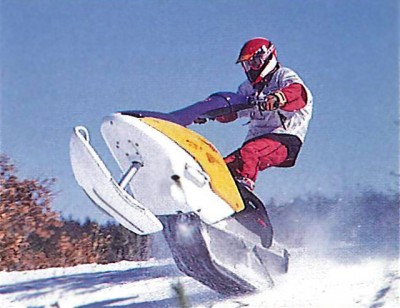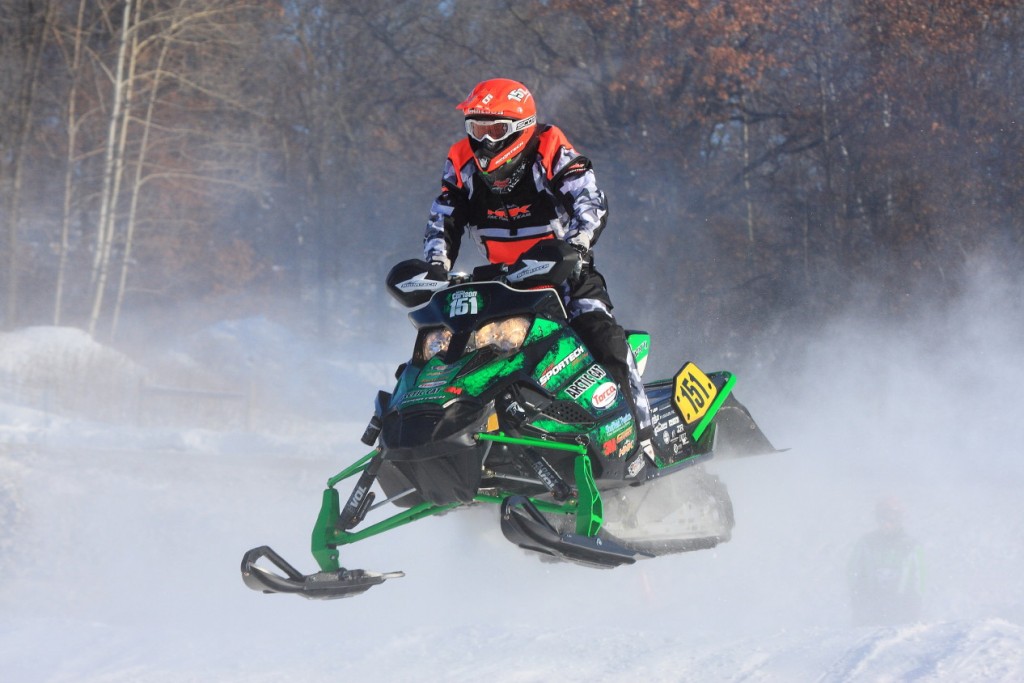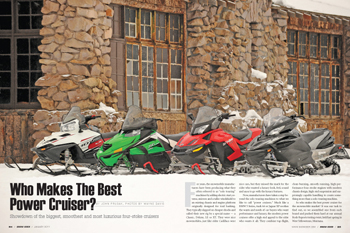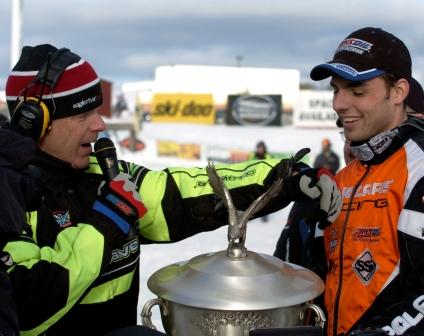A New Honda Snowmobile? That Was Pledged Just 13 Years Ago
Is Honda ever going to enter the snowmobile market? It’s a question that’s been asked a lot over the years, including recently at the 2016 Rode Reports testing event, where we got to ride the 2016 snowmobiles from Arctic Cat, Polaris, Ski-Doo and Yamaha.
Honda has definitely build some prototypes over the years, and has filed some patents for snowmobile-related components, but the company has never taken the big step. Most poo-poo the idea of Honda entering the modern snowmobile market, saying it’s too small of a market for Honda to reasonable enter, given what it would cost to tool up and establish a new product. But just 13 years ago, in April of 2002, I had an on-the-record conversation with then Honda Senior Vice President of the Motorcycle Division Ray Blank (now retired) about the topic, right after Honda entered the personal watercraft market.
The interview was done on behalf of our sister publication that covers the trade side of the industry — called Powersports Business. Blank’s answers were given just as the snowmobile market was coming out of the roaring ’90s, where the market grew by double-digit percentages many years, and was going into a shrinking phase, thanks to several bad winters in a row. We’re guessing that’s what caused Honda to move away from the snowmobile market. But could the company (again) reconsider? Directly below are excerpt of our interview with Blank in April of 2002. Also, below that is a reprint of a short article from 1997, when then Snow Goer/Snow Week/Snowmobile Magazine Assistant Editor Lynn Keillor and I had the rare opportunity to test a Honda prototype of a over-snow vehicle called the Motosled. While produced for snow parks in Japan, it never made it to the North American market.
Ray Blank Said A Honda Snowmobile Was Coming
POWERSPORTS BUSINESS: For years your people have been looking into the snowmobile industry and been asking, “Do you think the market is ready for a four-stroke?” Now Yamaha has come out with a product seems to prove that high-performance four-stroke snowmobiles [the original RX-1] can be built and can be accepted. Does that make more interesting to Honda, or now that somebody has broken that ice, does it make less interesting to Honda.
RAY BLANK: The reality is, looking at our powersports dealer network, it’s almost a given that at some point in time, we will look for those dealers who are in the appropriate location for some type of snow vehicle. Does it have to be a snowmobile as you know it today? Maybe not. Does it need to be something that those dealers can use in the same environment that we’re trying to create today, this broad demographic, this Honda store, does it have to work in that? Certainly. But I don’t know that it would be necessary to think that it has to simply follow the norms of ‘This is a snowmobile and this is our four-stroke snowmobile.’ It could be something different. And we’re looking even beyond the known categories, too. We’re working with a number of products that I can’t even tell you how to categorize right now that would be appropriate for the Powersports dealer concept. I think probably one of the most important things for us to do to sell this concept to dealers is having even more credibility than we even enjoy up until three years ago when we stated our three-year plan.
POWERSPORTS BUSINESS: So then, it sounds like you have to be coming with a snowmobile product soon?
RAY BLANK: It appears as though you’ve come to a conclusion… (laughs) We have been looking at that aspect of the business for a long time – a winter recreational product, a winter utility product – and we understand that if the Powersports [Honda eclusive dealership] concept is viable in the Snowbelt, it is going to have to include a product appropriate for those dealers that follows the same norms of the rest of the program.
POWERSPORTS BUSINESS: So, assuming you have a snow product, when would you expect to introduce it?
BLANK: Certainly, if we want to be successful with the program, we’re going to have to do something about that soon. If we are going to match our reasonable growth approach that we’ve taken with personal watercraft and the Powersports [Honda eclusive dealership] concept, we understand that within a relatively short period of time, we’re going to have to introduce a product in a category that is appropriate for dealers within the Snowbelt area. But it has to be innovative, and that always takes longer, because it’s going to be a Honda.
Test Ride On Honda Motosled — January 1997
In January of 1997, the Snow Goer/Snow Week team got to try a unique Honda Motosled. The vehicle hand a track, a single ski that was notably wide and was to be ridden like a stand-up personal watercraft. Here’s the short story from The Buzz department of the August 1997 issue of the Snow Goer magazine.
Thrown For A Loop With Honda’s Motosled
It’s a maybe-maybe not for Honda and its Motosled – the snow machine that looks like a personal watercraft.
This past winter, Honda had two such contraptions in North America for market testing, and based on their findings, they’ll decide whether or not to proceed with production. The folks at Honda gave us no indication as to when a final decision on the Motosled will occur.

The Motosled looks like a stand up personal watercraft, with a thick single ski in front and a 12- by 94-inch rubber snowmobile track in the rear. The machine’s power comes from a 246cc single cylinder, two-stroke engine. The Motosled also features electric start, CDI ignition, oil injection and a sleek body.
The rear suspension offers about 7 inches of travel, and the front has slightly less through a telescopic strut. In all, the sled has a listed dry weight of 284 pounds, or 304 pounds with all the juices.
We got a chance to try the Motosled last winter at our Wisconsin test facility. After watching Japanese Motosled instructors gracefully navigate around an open field and occasionally pop the machine into the air, we were invited to give it a try.
We were instructed to stand on the platform with our feet slightly spread. The moveable handpole was to stay at about waist height. We were then told to hit the thumb throttle and hard, because faster speeds increase the likelihood of staying upright. Lighter riders may also have a first-try advantage as the machine will not bog down as much on the start.
Cruising in a straight line was the easy part, but turning was a different story. Conventional snowmobile wisdom says to throw hips and upper body into a turn. Try this on the Motosled and you’ll do a faceplant. The trick rests in the lower leg. Pressing shins against the side panels will direct the machine, but it’s a tough concept for a snowmobiler to remember.
While the Motosled was a gas to spin around the field, it didn’t take too much to tire us out. It requires a lot of energy just to stay upright, not to mention lifting the machine out of the powder following a crash. And the Motosled is made for spinning around in powder or on a lake, not for actual transportation. In fact, it’s pretty boring to run it on groomed trials.
In an informal poll in our sister publication, Snow Week, most people who wrote in thought the Motosled was a neat idea. But whether the “neat idea” status will translate into “profit potential” still remains to be seen.




